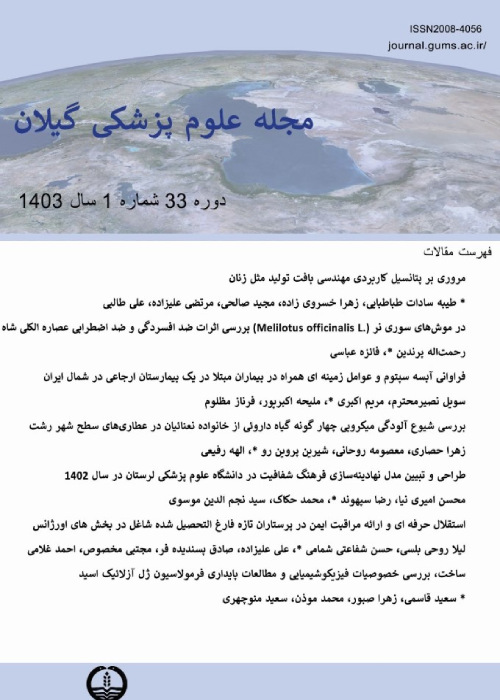Prevalence of Intestinal Parasitic Infections in the Urban Areas of Bandar Anzali, Northern Iran
Author(s):
Abstract:
Abstract
Introduction
Intestinal parasitic infections are among the most important health problems in different communities and even in developed countries. The adverse effects of these parasites on the development of human communities have been pointed out by WHO. Geographical situation، cultural and social behaviors، lack of safe drinking water and poor health standards، especially in rural areas are among the factors which affect the prevalence of parasitic infections in Iran. Objective
To evaluate the prevalence of intestinal parasitic infections in the urban areas of Bandar-Anzali district، northern Iran. Materials And Methods
A cross-sectional study was conducted from March 2010 to March 2011 in six different locations of Bandar-Anzali district، Guilan provine، northern Iran. A total of 700 fecal samples from different age groups were collected in clean plastic containers and examined for intestinal protozoa and helminthes using formalin-ether concentration and direct saline thin smear (for watery samples) techniques. Chi-square and Fisher''s exact tests were used for statistical analysis. The p-values were considered statistically significant at p<0. 05. Results
Of the 700 examined people، 457 cases (65. 3%) were female and 243 cases (34. 7%) were male. The overall prevalence of intestinal parasitic infections was 15. 1%، of which 3. 3% belong to pathogenic parasites. The most prevalent pathogenic parasites were sequentially Giardia lamblia (2. 14%)، Strongyloides stercoralis (0. 9%) and Hymenolepis nana (0. 3%). The highest prevalence of pathogenic parasites was seen in 10-49 age group and the lowest in ages over 50 years. Intestinal pathogenic parasitic infections were more endemic in females than that in males، 65. 2% versus 34. 8%، respectively. Blastocystis hominis (6. 4%)، Endolimax nana (3. 9%)، Entamoeba coli (2. 6%)، Iodamoeba buetschlii (0. 3%) and Entamoeba histolytica/E. dispar (0. 1%) were the most non-pathogenic parasitic protozoa in the studied population. Conclusion
According to the results، the overall prevalence of intestinal parasitic infections in Bandar-Anzali was found to be 3. 3% which indicates a significant decrease، in comparison to the reported prevalence in past decades. The explanation could be improvements in environmental and personal health، drinking water and food safety، public health education and proper waste disposal. Conflict of interest: non declaredKeywords:
Language:
Persian
Published:
Journal Of Guilan University Of Medical Sciences, Volume:22 Issue: 88, 2014
Pages:
18 to 25
magiran.com/p1214852
دانلود و مطالعه متن این مقاله با یکی از روشهای زیر امکان پذیر است:
اشتراک شخصی
با عضویت و پرداخت آنلاین حق اشتراک یکساله به مبلغ 1,390,000ريال میتوانید 70 عنوان مطلب دانلود کنید!
اشتراک سازمانی
به کتابخانه دانشگاه یا محل کار خود پیشنهاد کنید تا اشتراک سازمانی این پایگاه را برای دسترسی نامحدود همه کاربران به متن مطالب تهیه نمایند!
توجه!
- حق عضویت دریافتی صرف حمایت از نشریات عضو و نگهداری، تکمیل و توسعه مگیران میشود.
- پرداخت حق اشتراک و دانلود مقالات اجازه بازنشر آن در سایر رسانههای چاپی و دیجیتال را به کاربر نمیدهد.
In order to view content subscription is required
Personal subscription
Subscribe magiran.com for 70 € euros via PayPal and download 70 articles during a year.
Organization subscription
Please contact us to subscribe your university or library for unlimited access!



